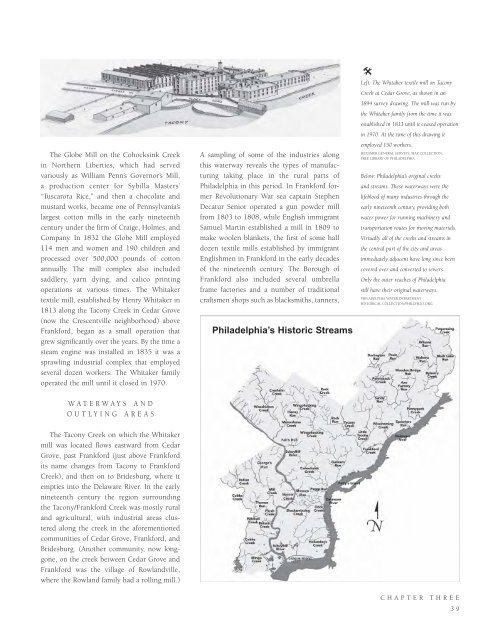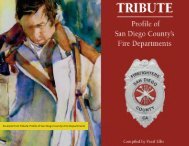In The Cradle of Industry and Liberty
An illustrated history of Philadelphia's manufacturing sector paired with the histories of local companies that make the city great.
An illustrated history of Philadelphia's manufacturing sector paired with the histories of local companies that make the city great.
Create successful ePaper yourself
Turn your PDF publications into a flip-book with our unique Google optimized e-Paper software.
<strong>The</strong> Globe Mill on the Cohocksink Creek<br />
in Northern Liberties, which had served<br />
variously as William Penn’s Governor’s Mill,<br />
a production center for Sybilla Masters’<br />
“Tuscarora Rice,” <strong>and</strong> then a chocolate <strong>and</strong><br />
mustard works, became one <strong>of</strong> Pennsylvania’s<br />
largest cotton mills in the early nineteenth<br />
century under the firm <strong>of</strong> Craige, Holmes, <strong>and</strong><br />
Company. <strong>In</strong> 1832 the Globe Mill employed<br />
114 men <strong>and</strong> women <strong>and</strong> 190 children <strong>and</strong><br />
processed over 500,000 pounds <strong>of</strong> cotton<br />
annually. <strong>The</strong> mill complex also included<br />
saddlery, yarn dying, <strong>and</strong> calico printing<br />
operations at various times. <strong>The</strong> Whitaker<br />
textile mill, established by Henry Whitaker in<br />
1813 along the Tacony Creek in Cedar Grove<br />
(now the Crescentville neighborhood) above<br />
Frankford, began as a small operation that<br />
grew significantly over the years. By the time a<br />
steam engine was installed in 1835 it was a<br />
sprawling industrial complex that employed<br />
several dozen workers. <strong>The</strong> Whitaker family<br />
operated the mill until it closed in 1970.<br />
WATERWAYS AND<br />
OUTLYING AREAS<br />
A sampling <strong>of</strong> some <strong>of</strong> the industries along<br />
this waterway reveals the types <strong>of</strong> manufacturing<br />
taking place in the rural parts <strong>of</strong><br />
Philadelphia in this period. <strong>In</strong> Frankford former<br />
Revolutionary War sea captain Stephen<br />
Decatur Senior operated a gun powder mill<br />
from 1803 to 1808, while English immigrant<br />
Samuel Martin established a mill in 1809 to<br />
make woolen blankets, the first <strong>of</strong> some half<br />
dozen textile mills established by immigrant<br />
Englishmen in Frankford in the early decades<br />
<strong>of</strong> the nineteenth century. <strong>The</strong> Borough <strong>of</strong><br />
Frankford also included several umbrella<br />
frame factories <strong>and</strong> a number <strong>of</strong> traditional<br />
craftsmen shops such as blacksmiths, tanners,<br />
Philadelphia’s Historic Streams<br />
@<br />
Left: <strong>The</strong> Whitaker textile mill on Tacony<br />
Creek at Cedar Grove, as shown in an<br />
1894 survey drawing. <strong>The</strong> mill was run by<br />
the Whitaker family from the time it was<br />
established in 1813 until it ceased operation<br />
in 1970. At the time <strong>of</strong> this drawing it<br />
employed 150 workers.<br />
HEXAMER GENERAL SURVEYS, MAP COLLECTION,<br />
FREE LIBRARY OF PHILADELPHIA.<br />
Below: Philadelphia’s original creeks<br />
<strong>and</strong> streams. <strong>The</strong>se waterways were the<br />
lifeblood <strong>of</strong> many industries through the<br />
early nineteenth century, providing both<br />
water power for running machinery <strong>and</strong><br />
transportation routes for moving materials.<br />
Virtually all <strong>of</strong> the creeks <strong>and</strong> streams in<br />
the central part <strong>of</strong> the city <strong>and</strong> areas<br />
immediately adjacent have long since been<br />
covered over <strong>and</strong> converted to sewers.<br />
Only the outer reaches <strong>of</strong> Philadelphia<br />
still have their original waterways.<br />
PHILADELPHIA WATER DEPARTMENT<br />
HISTORICAL COLLECTION/PHILLYH2O.ORG.<br />
<strong>The</strong> Tacony Creek on which the Whitaker<br />
mill was located flows eastward from Cedar<br />
Grove, past Frankford (just above Frankford<br />
its name changes from Tacony to Frankford<br />
Creek), <strong>and</strong> then on to Bridesburg, where it<br />
empties into the Delaware River. <strong>In</strong> the early<br />
nineteenth century the region surrounding<br />
the Tacony/Frankford Creek was mostly rural<br />
<strong>and</strong> agricultural, with industrial areas clustered<br />
along the creek in the aforementioned<br />
communities <strong>of</strong> Cedar Grove, Frankford, <strong>and</strong><br />
Bridesburg. (Another community, now longgone,<br />
on the creek between Cedar Grove <strong>and</strong><br />
Frankford was the village <strong>of</strong> Rowl<strong>and</strong>ville,<br />
where the Rowl<strong>and</strong> family had a rolling mill.)<br />
CHAPTER THREE<br />
39
















